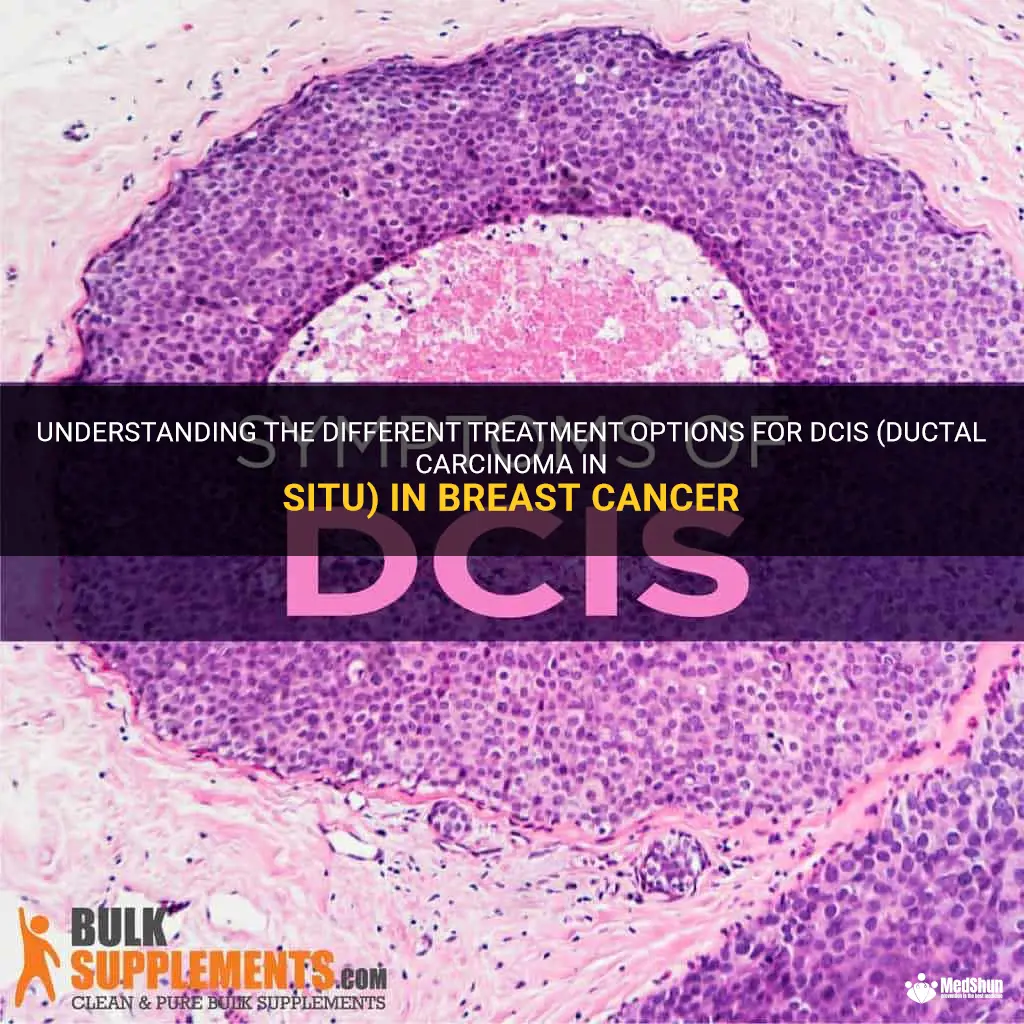
Breast cancer is a complex and challenging disease that affects millions of people worldwide. One specific type of breast cancer that poses unique challenges in diagnosis and treatment is ductal carcinoma in situ (DCIS). DCIS is a non-invasive breast cancer that starts in the milk ducts and has the potential to become invasive if left untreated. While it may sound intimidating, the good news is that there are highly effective treatment options available for DCIS patients. In this article, we will explore some of the innovative and cutting-edge treatment approaches for DCIS and the impact they have on the lives of those affected by this condition.
| Characteristics | Values |
|---|---|
| Stage | DCIS |
| Treatment | Surgery, Radiation, Hormone Therapy |
| Surgery Options | Lumpectomy, Mastectomy |
| Radiation | External beam radiation therapy |
| Hormone Therapy | Tamoxifen, Aromatase inhibitors |
| Side Effects | Pain, Fatigue, Skin changes, Lymphedema |
| Recurrence Risk | Low to Moderate |
| Prognosis | Excellent with appropriate treatment |
| Follow-up Care | Regular mammograms, check-ups, self-exams |
| Support Services | Support groups, counseling, survivorship programs |
What You'll Learn
- What are the different treatment options for DCIS (ductal carcinoma in situ) breast cancer?
- How effective is radiation therapy as a treatment for DCIS breast cancer?
- Are there any alternative or complementary treatments available for DCIS breast cancer?
- What are the potential side effects of surgery as a treatment for DCIS breast cancer?
- How long does treatment for DCIS breast cancer typically last, and what is the recovery process like?

What are the different treatment options for DCIS (ductal carcinoma in situ) breast cancer?
Ductal carcinoma in situ (DCIS), also known as stage 0 breast cancer, is a non-invasive form of breast cancer where abnormal cells are found in the lining of the milk ducts but have not spread to surrounding tissue. DCIS is considered a pre-cancerous condition as it has the potential to become invasive if left untreated. It is often detected through mammograms and is more commonly diagnosed in women over the age of 50.
The treatment options for DCIS vary depending on several factors, including the characteristics of the tumor, the patient's overall health, and personal preferences. The main goal of treatment for DCIS is to prevent the development of invasive breast cancer and to minimize the risk of recurrence.
One of the primary treatment options for DCIS is surgery. The surgical options include breast-conserving surgery, such as lumpectomy, or removal of the entire breast, known as mastectomy. During a lumpectomy, the surgeon removes the abnormal cells along with a surrounding margin of healthy tissue. This procedure is often followed by radiation therapy to destroy any remaining abnormal cells. Mastectomy is typically recommended for cases where the tumor is large, or there are multiple areas of DCIS spread throughout the breast.
Radiation therapy is another common treatment option for DCIS and is often used in conjunction with surgery. It involves the use of high-energy X-rays or other particles to kill cancer cells. Radiation therapy is typically delivered daily over a period of several weeks. This treatment is effective in reducing the risk of recurrence and is often recommended for patients who have undergone lumpectomy.
Hormonal therapy may be recommended in certain cases of DCIS, particularly if the tumor is hormone receptor-positive. Hormonal therapy includes the use of drugs such as tamoxifen or aromatase inhibitors, which help to block the effects of estrogen on breast tissue. These medications can reduce the risk of recurrence and are typically taken for five to ten years.
In some cases, clinical trials may offer additional treatment options for DCIS. These trials test new treatment approaches or combinations of therapies to evaluate their effectiveness and safety. Participation in a clinical trial may provide access to innovative treatments that are not yet widely available.
It is important for individuals diagnosed with DCIS to discuss their treatment options with a healthcare provider to determine the best course of action based on their individual circumstances. Factors such as the size and location of the tumor, the presence of hormone receptors, and personal preferences will all influence the choice of treatment. Early detection and treatment of DCIS can greatly improve outcomes and reduce the risk of invasive breast cancer.
The Lingering Effects: How Breast Cancer Treatment Can Impact Tear Ducts for Years After Treatment
You may want to see also

How effective is radiation therapy as a treatment for DCIS breast cancer?
Radiation therapy is a common treatment for ductal carcinoma in situ (DCIS), a non-invasive form of breast cancer. DCIS is characterized by the presence of abnormal cells in the milk ducts of the breast, which have not spread beyond the ducts into the surrounding breast tissue. While DCIS is considered a pre-cancerous condition, it can progress to invasive breast cancer if left untreated.
Radiation therapy is often recommended after surgery to remove the abnormal cells in the breast. It involves the use of high-energy X-rays or other types of radiation to kill any remaining cancer cells and reduce the risk of recurrence. Radiation therapy can be delivered externally or internally, depending on the specific case.
External beam radiation therapy is the most common form of radiation therapy for DCIS. It involves the use of a machine called a linear accelerator that delivers radiation to the breast from outside the body. The patient lies on a table while the machine rotates around them, targeting the breast from different angles. This allows for precise delivery of radiation to the affected area while minimizing exposure to surrounding healthy tissues.
Internal radiation therapy, also known as brachytherapy, is another option for some patients with DCIS. It involves the placement of a radioactive source inside the breast, either temporarily or permanently. The source is inserted using a catheter or seed, and it delivers a high dose of radiation directly to the targeted area.
Numerous studies have shown the effectiveness of radiation therapy in reducing the risk of recurrence in patients with DCIS. For example, a study published in the Journal of Clinical Oncology found that radiation therapy after surgery reduced the risk of local recurrence by 60% in patients with DCIS. Another study published in the New England Journal of Medicine showed that radiation therapy reduced the risk of invasive breast cancer by 50% in patients with DCIS.
In addition to reducing the risk of recurrence, radiation therapy has also been shown to improve overall survival rates in patients with DCIS. A study published in the journal Cancer Epidemiology, Biomarkers & Prevention found that radiation therapy after surgery improved 10-year survival rates in patients with DCIS by 2-3%.
While radiation therapy is generally effective in the treatment of DCIS, it is not without potential side effects. Common side effects include fatigue, skin changes in the treated area, and mild to moderate breast pain. These side effects are usually temporary and can be managed with appropriate supportive care.
In conclusion, radiation therapy is an effective treatment for DCIS breast cancer. It reduces the risk of recurrence and improves overall survival rates in patients with this condition. While it can cause temporary side effects, the benefits of radiation therapy outweigh the risks in most cases. It is important for patients to discuss the potential benefits and risks of radiation therapy with their healthcare team to determine if it is the right treatment option for them.

Are there any alternative or complementary treatments available for DCIS breast cancer?
DCIS (Ductal Carcinoma In Situ) is a non-invasive form of breast cancer, where cancer cells are confined within the milk ducts of the breast. While DCIS itself is not life-threatening, it is considered a precancerous condition, and treatment is typically recommended to prevent the development of invasive breast cancer.
The standard treatment for DCIS is surgical removal of the affected tissue, either through a lumpectomy (removal of the tumor and surrounding tissue) or mastectomy (removal of the entire breast). However, some individuals may seek alternative or complementary treatments to support their conventional treatment or as standalone options.
It is important to note that these alternative or complementary treatments have not been extensively studied in the context of DCIS, and their effectiveness and safety are not well-established. It is always advisable to consult with a healthcare professional before considering any alternative or complementary treatments.
Here are a few alternative or complementary treatments that some individuals may consider for DCIS:
- Herbal supplements: Some herbal supplements, such as turmeric, green tea extract, and medicinal mushrooms, have been studied for their potential anti-cancer properties. However, evidence regarding their effectiveness in treating DCIS is limited, and they should not be used as a substitute for conventional treatment.
- Acupuncture: Acupuncture is a traditional Chinese medicine practice that involves inserting thin needles into specific points on the body to promote healing and balance. While acupuncture has been shown to help manage certain cancer-related symptoms, such as pain and nausea, its effectiveness in treating DCIS is unknown.
- Mind-body techniques: Mind-body techniques, such as meditation, yoga, and guided imagery, have been shown to reduce stress and improve overall well-being in cancer patients. These practices may help individuals cope with the emotional and physical challenges of DCIS, but their impact on the course of the disease is unclear.
- Dietary changes: Adopting a healthy diet, rich in fruits, vegetables, whole grains, and lean proteins, may support overall health and may have a positive impact on reducing the risk of cancer development. However, no specific diet has been proven to prevent or treat DCIS.
- Lifestyle modifications: Making certain lifestyle changes, such as quitting smoking, reducing alcohol consumption, and maintaining a healthy weight, may help lower the risk of developing invasive breast cancer. These lifestyle modifications are recommended as part of the overall prevention strategy for breast cancer, including DCIS.
It is crucial to emphasize that alternative or complementary treatments should not replace conventional treatment for DCIS. Surgical removal of the affected tissue remains the gold standard and the most effective way to prevent progression to invasive breast cancer.
In conclusion, while some individuals may explore alternative or complementary treatments for DCIS, there is limited scientific evidence to support their effectiveness. It is important to consult with a healthcare professional before considering any alternative treatments and to adhere to the recommended conventional treatment plan.
What to Expect after Your First Radiation Treatment for Breast Cancer
You may want to see also

What are the potential side effects of surgery as a treatment for DCIS breast cancer?
Potential Side Effects of Surgery as a Treatment for DCIS Breast Cancer
Surgery is one of the most common treatments for ductal carcinoma in situ (DCIS), a non-invasive form of breast cancer. While surgery is generally effective in removing the cancerous cells, there are potential side effects that patients should be aware of. These side effects can vary depending on the type of surgery performed and the individual's unique circumstances.
One potential side effect of surgery for DCIS is pain and discomfort at the surgical site. This is common after any surgical procedure and can be managed with pain medication prescribed by the surgeon. Additionally, patients may experience swelling and bruising around the incision site, which typically resolves over time. It is important for patients to follow their surgeon's recommendations regarding post-operative care and taking care of the surgical site to minimize these side effects.
Another potential side effect of surgery for DCIS is infection. While surgeons take precautions to minimize the risk of infection during surgery, it can still occur. Signs of infection include redness, warmth, swelling, increased pain, and discharge from the incision site. If these symptoms develop, it is important to contact the surgeon promptly for evaluation and treatment with antibiotics.
In rare cases, surgery for DCIS can result in hematoma or seroma formation. A hematoma is a collection of blood outside of blood vessels, while a seroma is a collection of watery fluid. These fluid collections can be uncomfortable and may require drainage to alleviate symptoms. Most seromas and hematomas resolve on their own over time, but in some cases, additional intervention may be necessary.
One potential long-term side effect of surgery for DCIS is lymphedema. Lymphedema is a condition characterized by swelling in the arm or hand on the same side as the surgery. It is caused by damage to the lymphatic system during surgery, which can result in the accumulation of lymph fluid. Lymphedema can be managed with various treatments, including compression garments, exercise, and manual lymphatic drainage.
Psychological side effects are also possible after surgery for DCIS. Some individuals may experience anxiety, depression, or difficulty adjusting to life after surgery. Support groups, counseling, and other resources are available to help patients cope with these emotional challenges.
While the risks and potential side effects of surgery for DCIS should not be underestimated, it is important to remember that this treatment is often highly successful in removing cancerous cells and preventing the progression of the disease. It is crucial for patients to discuss any concerns or questions with their surgical team to ensure they have a clear understanding of the potential side effects and steps they can take to minimize them.
In conclusion, surgery is a common and effective treatment for DCIS breast cancer. While there are potential side effects, such as pain, infection, fluid collections, lymphedema, and psychological challenges, these can be managed with appropriate care and support. It is important for patients to have open and honest discussions with their healthcare providers to fully understand the potential risks and benefits of surgery as a treatment for DCIS.
The Benefits and Side Effects of Breast Cancer Treatment with Arimidex
You may want to see also

How long does treatment for DCIS breast cancer typically last, and what is the recovery process like?
Treatment for ductal carcinoma in situ (DCIS), a non-invasive form of breast cancer, generally involves surgery, radiation therapy, and/or hormone therapy. The duration of treatment and recovery process can vary depending on individual factors and the specific treatment plan.
Surgery is often the first line of treatment for DCIS. The most common surgical procedure for DCIS is lumpectomy, which involves removing the tumor and a small amount of surrounding healthy tissue. In some cases, a mastectomy may be recommended, where the entire breast is removed. After surgery, the recovery process typically involves a few weeks of healing, during which time patients may experience some discomfort or pain. However, most are able to resume normal activities within a few days to a couple of weeks.
After surgery, radiation therapy is often recommended to destroy any remaining cancer cells and reduce the risk of recurrence. Radiation therapy typically involves daily treatments over a period of several weeks. Each treatment session is fast and painless, usually lasting only a few minutes. Common side effects of radiation therapy include temporary skin changes and fatigue. The recovery process after radiation therapy varies, with most patients experiencing minimal side effects that resolve within a few weeks after treatment completion.
In addition to surgery and radiation therapy, hormone therapy may be prescribed for DCIS that is hormone receptor positive. This type of therapy involves taking medications that block the effects of estrogen or lower its levels in the body. Hormone therapy is typically taken for a period of five to ten years. Side effects can include hot flashes, mood swings, and joint pain. The recovery process during hormone therapy involves managing these side effects and continuing regular follow-up appointments with the healthcare team.
During the entire treatment process, it is common for patients to undergo regular check-ups and imaging tests to monitor for any signs of recurrence or progression. These follow-up appointments are crucial for early detection and effective management of DCIS.
It is important to note that each individual's treatment plan and recovery process may vary. Factors such as the stage and extent of the cancer, overall health, and personal preferences can influence the duration of treatment and recovery. Therefore, it is essential to discuss treatment options and expectations with a healthcare team to ensure personalized care and support throughout the entire process.
In conclusion, treatment for DCIS breast cancer typically involves surgery, radiation therapy, and/or hormone therapy. The duration of treatment can vary depending on individual factors and the specific treatment plan. The recovery process may involve a few weeks of healing after surgery, minimal side effects during and after radiation therapy, and managing side effects during hormone therapy. Regular follow-up appointments and check-ups are important for long-term monitoring and early detection of recurrence.
Advancements in Breast Cancer Treatment: The Current Landscape in the Netherlands
You may want to see also
Frequently asked questions
The most common treatment for DCIS (ductal carcinoma in situ) is surgery. This often involves a lumpectomy, where the tumor and a small margin of normal breast tissue are removed. In some cases, a mastectomy may be recommended, where the entire breast is removed.
In addition to surgery, other treatment options for DCIS include radiation therapy and hormone therapy. Radiation therapy is often recommended after surgery to help reduce the risk of the cancer recurring. Hormone therapy may be recommended for hormone receptor-positive DCIS, as it can help lower the risk of recurrence.
Side effects of radiation therapy for DCIS can vary, but commonly include skin changes, such as redness, itching, and peeling in the treated area. Fatigue, breast swelling or tenderness, and changes in the treated breast's appearance are also possible side effects. These side effects are usually temporary and improve over time.
DCIS always requires some form of treatment, but the specific approach may vary depending on the individual case. While DCIS itself is not considered invasive breast cancer, it has the potential to become invasive if left untreated. Therefore, treatment is necessary to reduce the risk of the cancer spreading or recurring.







